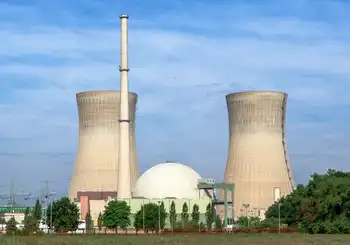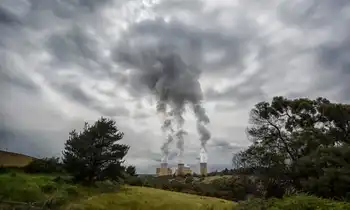Coal-fired plant will have 90 per cent fewer pollutants
OMAHA, NEBRASKA - The new coal plant that the Omaha Public Power District is building near Nebraska City will release significantly less air pollution than other plants already operating in the state.
Tougher federal environmental laws will reduce some pollutants by 90 percent.
The cost of the new pollution technology is estimated at $65 million - about 8 percent of the plant's total.
State and federal regulators say OPPD will be using the best available technology.
"This isn't your parents' coalfired plant," said Brad Reid of the Nebraska Department of Environmental Quality. "This facility is not the old, dirty, coalfired plants thrown up in the 1970s."
Even so, with a capacity to burn about 340 tons of coal an hour, 24 hours a day, such a plant could send thousands of tons of pollution into the air each year.
Federal studies indicate that pollution from power plants contributes to asthma attacks, bronchitis, heart disease and thousands of premature deaths.
State regulators have studied the impact of the new plant by taking into account other facilities within about 30 miles. Based on those models, the air around Nebraska City should continue to meet federal standards.
OPPD is building the 660-megawatt plant about five miles southeast of Nebraska City, where it already has a coal plant of a similar size. Construction of the $800 million facility is scheduled to start this year, and begin generating electricity in 2009.
In deciding what constitutes the best pollution-control technology, the state examined cost, environmental impact, the equipment's track record and effectiveness.
For example, OPPD is opting for a sulfur-removal technology with annualized costs that are about 22 percent less than another method available - while operating on less energy and generating less liquid waste.
Nebraska's strong winds will distribute most of the pollution across a wide area. The smokestack will rise 400 feet - roughly 35 stories - to further guarantee wide dispersal.
On calm days, though, the state estimates the bulk of pollutants will dissipate within a quarter of a mile to 12 miles.
"The emissions... are being controlled as well or better than any plant in the U.S.," said Bill Neal of OPPD.
Some of the pollution controls that will be used at the plant have a long track record elsewhere, while others don't.
Reid said people should feel "extremely confident" with the fabric filters that OPPD will use to keep dust and smoke from blanketing the area.
On the other hand, the equipment being installed to reduce nitrogen oxide has not been fully proved for the type of coal OPPD burns. As a result, the state is giving the utility 18 months to break it in, with the possibility of a waiver if OPPD is less than successful. Reid said the state expects OPPD to meet the tougher standard.
Nitrogen oxide causes respiratory problems.
Any success with the nitrogen oxide equipment will be an improvement, as no similar controls are in use on existing Nebraska coal plants.
The mercury controls also are unproved. Although mercury is a potent neurotoxin, the federal government won't start regulating it until this year.
Unlike a smaller coal plant being built near Hastings, this one appears to have community acceptance. No objections have been filed with the state.
Kay Oestmann, director of the Southeast (Nebraska) District Health Department, said people may be comfortable because the existing OPPD plant has been well run and the new one will have even better controls.
"There haven't been any problems that have forced the community to think that anything would happen to impact their health," she said.
Of the electricity being generated, half will be used by OPPD. The other half will be sold to public utilities in Nebraska, Missouri and Minnesota.
In Hastings, Neb., vocal opposition surfaced to plans by eight utilities to build a 220-megawatt plant.
Diane Beachly, one of those opposed to the Hastings plant, said it didn't seem right that the local air should be fouled so that those on the eastern side of the state could have electricity.
"The plant should be located near where people will be using the electricity," she said.
How new coal plant addresses pollution Key pollutants, annual emission limit, effect on health or the environment, and what OPPD proposes to do: Particulate matter (dust and smoke), 1,121 tons; aggravates asthma, bronchitis and other breathing problems and linked to premature death.
OPPD already filters out 99 percent of dust at its existing plants. The new Nebraska City facility will use newer, even more effective technology. Known as baghouses, the cloth filters will do a better job of trapping particles believed to be the most harmful. Sulfur dioxide, 2,839 tons; contributes to respiratory and heart problems and acid rain.
As the sulfur-containing gases pass through the furnace's exhaust system, OPPD will spray them with a mist that contains calcium. The calcium reacts with the sulfur to form solid salts, which are then taken to landfills. Nitrogen oxide, 2,002 tons (3,405 tons during the first 18 months of operation); linked to acute respiratory problems and impairs immune systems. Damages crops and other plants.
OPPD will minimize the creation of nitrogen oxide by getting the coal to burn efficiently. And it will use a chemical reaction called selective catalytic reduction to convert the nitrogen oxide into water and nitrogen gas. Mercury, which causes brain damage and is especially harmful to fetuses.
OPPD will follow yet-to-be-set federal limits. One possibility is using carbon to absorb the mercury from the flue gases. Carbon dioxide; coal plants are a major source of this global-warming gas.
There are no federal laws restricting this gas, thus the plant includes no technology to address it.
Related News

Net-Zero Emissions Might Not Be Possible Without Nuclear Power
LONDON - Declining solar, wind, and battery technology costs are helping to grow the share of renewables in the world’s power mix to the point that governments are pledging net-zero emission electricity generation in two to three decades to fight global warming.
Yet, electricity grids will continue to require stable baseload to incorporate growing shares of renewable energy sources and ensure lights are on even when the sun doesn’t shine, or the wind doesn’t blow. Until battery technology evolves enough—and costs fall far enough—to allow massive storage and deployment of net-zero electricity to the grid, the systems will continue to need…




